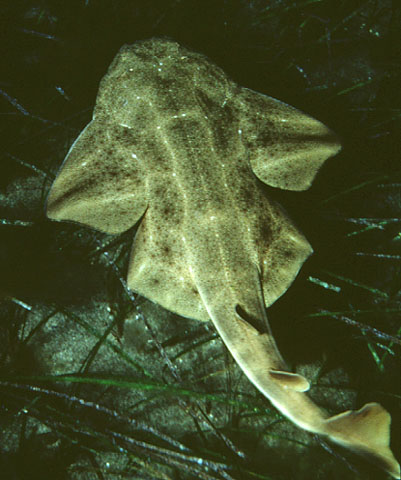| Squatinidae (Angel sharks) |
| 183 cm TL (male/unsexed); 244 cm TL (female); max.weight: 80 kg |
|
demersal; brackish; marine; depth range 5 - 150 m, oceanodromous |
| Northeast Atlantic: southern Norway, Sweden and Shetland Islands to Morocco and West Sahara, including the Canary Islands, the Mediterranean and the Black Sea (Ref. 247). Range and abundance declining 1severely throughout its range; proposed legal protection in Britain (Ref.58085). The European Council Regulations 43/2009, 23/2010, 57/2011, 44/2012, 40/2013, 43/2014, 2015/104 and 2016/72 prohibit to fish for, to retain on board, to tranship and to land the S. squatina in all waters from the European Community (F. Osaer, pers.comm. 04/2016). |
|
Dorsal spines (total): 0-0; Dorsal soft rays (total): 0-0. Broad flattened body, with enlarged pectoral and pelvic fins, no anal fin. Eyes and large spiracles dorsally. Gill openings at the sides of the head. The mouth is terminal. Coloration variable, from grey to reddish or greenish-brown with scattered small white spots and blackish dots dorsally (Ref. 78469). No ocelli on body (Ref. 247). |
| A benthic species that occurs inshore, on coasts and along the continental shelf; may enter estuaries (Ref. 247, 58085). Found mainly on sand or mud bottoms; sluggish by day, lying buried with eyes protruding. Also utilizes areas with macroalgae, kelp or rocks (Ref. 88920). Nocturnal species, swims off bottom at night. Feeds mainly on flatfishes and other benthic fishes, but also on skates, crustaceans and molluscs, with one record of swallowed cormorant (Ref. 247, 28070). Moves to deeper waters during winter, returning to the shallower depths in the spring (Ref. 88187), moving northwards in summer. Ovoviviparous (Ref. 50449, 107715). Females generally grow larger than males (Ref. 58137, 107710, 107713, 107715). Detects weak electric fields generated by other organisms (e.g. potential prey) (Ref. 10311). The marine leech Stibarobdella macrothela is a common parasite (Ref. 107712) and the isopod Aegapheles deshaysiana a common micropredator (Ref. 107714) for this shark species in the Canary Islands. Utilized fresh and dried salted for human consumption, and possibly for oil and fishmeal (Ref. 247). Reaches 250 cm (Ref. 35388). |
|
Critically Endangered (CR); Date assessed: 12 July 2017 (A2bcd) Ref. (130435)
|
| traumatogenic |
Source and more info: www.fishbase.org. For personal, classroom, and other internal use only. Not for publication.

